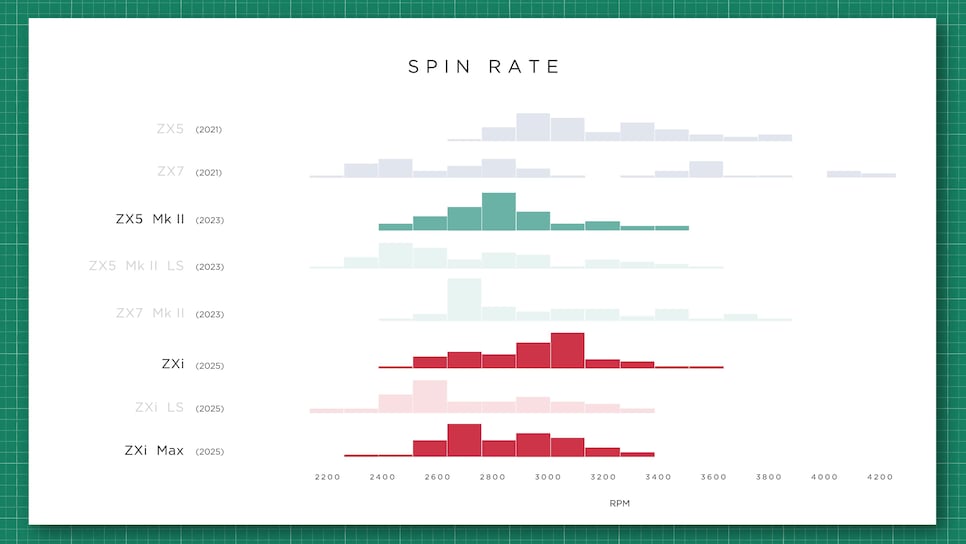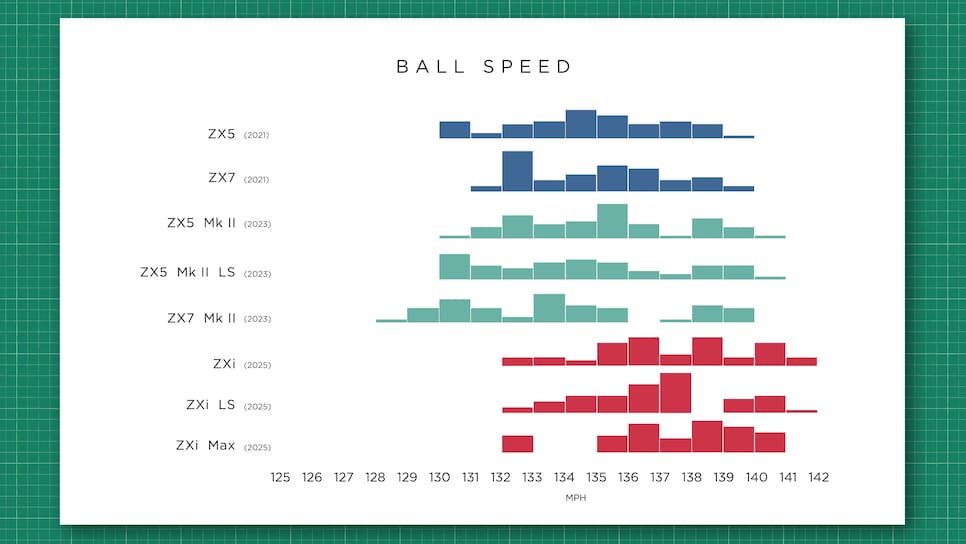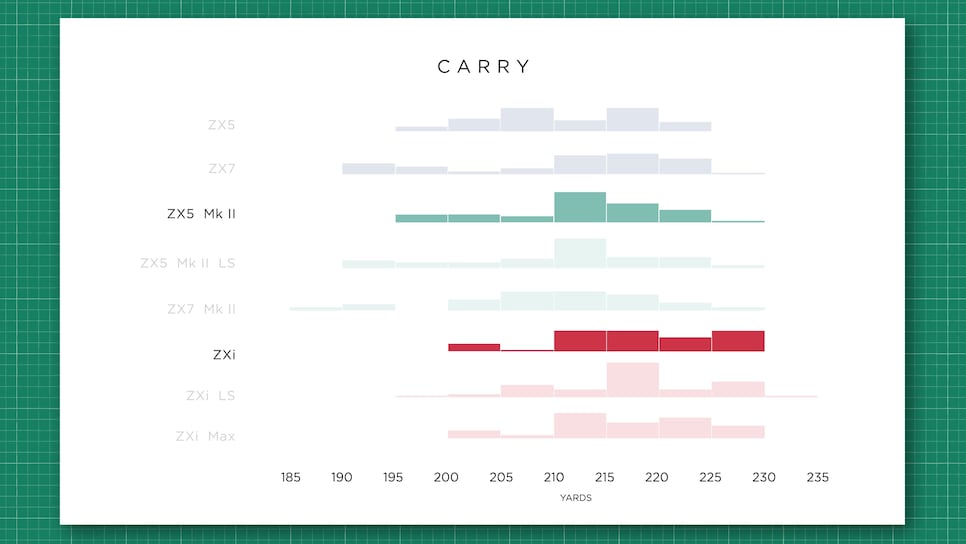Srixon isn’t like most of its competitors. Instead of churning out fresh drivers each year, the brand runs on an every-other-year cadence, meaning there’s additional time for the R&D department to breathe in between releases.
RELATED: Take a closer Look at Srixon’s ZXi Metals
The obvious question is whether an extra year of collaboration and design provides a meaningful performance edge.
We all want to know how the products differ and whether it’s worth testing or possibly upgrading. Fortunately, we have a swing robot that can deliver the ultimate gear cheat sheet.
Testing protocol
When we test clubs, we run each 10.5-degree head at 95mph — right around the average speed for an amateur golfer. This lets us gather a ton of useful data, from spin rate and dispersion to ball speed and carry distance across 9 different impact locations on the face. We also use the same shaft to create a true apples-to-apples comparison. We’re able to acquire meaningful data points for 90 percent of the face, so practically every kind of miss is accounted for.
Here’s what we found when we took the last three Srixon drivers for a spin.
1. Spin rate 
We love starting with launch and spin because both metrics can make or break your driver. Erratic launch and spin numbers on mis-hits — and you’re going to mis-hit the ball — can lead to wild swings in carry distance and dispersion. Reloads off the tee could become a common sight.
You want both of these metrics to remain consistent, regardless of where the ball is impacting the face.
Launch angles across the board remained steady over the last three generations, and you could say the same thing for spin rates when looking at the bar charts. Comparing ZXi models to the previous two years, we’re seeing slightly lower spins across the board, but it’s not always significant.

The bar charts tell us ZX5 MK2 had more shots recorded at 2,400-3,000 than ZXi and ZXi Max, so it has the potential to be the lowest spinning option if you opt for a more forgiving model. Spin ranges are fairly similar over the last two versions, too.
ZXi LS is the lone model that saw spin change in a meaningful way. We’re seeing roughly 400 RPMs less spin versus MK2 LS, but here’s where the data visuals offer an interesting perspective. I’ve already mentioned the importance of having consistent spin rates, and this is a prime example.
We’re seeing spin tighten on the high and low end with ZXi LS, which translates to better performance on misses. It’s a night-and-day improvement from ZX7 where the spin rates were all over the place.
2. Ball speed 
You could be thinking: OK, the spin rates for ZXi and ZXi Max didn’t change all that much in the last 6 years. Does that mean speed is flat as well? Nope! We’re seeing roughly 75 percent of the 54 shots recorded across the face achieve a ball speed between 136 to 142 mph. That number drops to just 32 percent for the same ball speed range with ZX5 MK2 and ZX5.
Let’s be real: You’re not going to pure it out of the center every time. So are you willing to take a chance and gain less ball speed on those mishits? It’s a question that’s worth pondering.

It’s more of the same for ZXi LS. Roughly 67 percent of shots achieved a ball speed between 136 and 142. You could make a case the ZX7 from a few versions ago was the closest comp to ZXi LS, but it’s still at a 35 percent clip in the same ball speed range — and don’t forget spin was all over the map.
From a pure speed perspective, it’s obvious the ZXi products give you more speed potential on the top end. And that’s exactly what you want.
3. Carry distance .jpg.rend.hgtvcom.966.544.suffix/1750771697415.jpeg)
Ball speed is important, but only if it’s tied to reliable launch and spin numbers. We’ve seen spin remain consistent and ball speed tick up — and here’s where those metrics reward you with more carry distance.
The ZXi is roughly 10 yards longer than ZX5 MK2. That’s a club less into the hole. No one is going to complain about that. The carry charts are nearly identical to what we saw with the ball speed charts — a higher concentration of carries from 217.5 to 230 yards. And the carry range is tight, so the potential for a squirrely carry is greatly reduced.

It’s more of the same with ZXi LS: 10 yards longer than the previous two models due to consistent ball speeds and spin numbers. And 70 percent of the shots are winding up within 217.5 and 230 yards. To have that kind of consistency with a low-spin driver is impressive.
4. Dispersion 
Looking at the dispersion box plot, the one thing that stands out is the number of shots landing in tighter groupings. From ZX5 to ZX5 MK2, the spread-out dots reveal a dispersion that went the wrong way. Now we’re seeing ZXi and ZXi Max go in the correct direction. ZXi produced one of the straightest balls and tightest dispersions we saw during robot testing — even more so than ZX5. ZXi Max has more of a left bias for golfers who fight a slice. But it’s consistently left and tightly bunched.
Funny enough, we’ve seen the low-spin offerings flip-flop from being more left-biased to right-biased. And again, the dots indicate we aren’t seeing a ton of variance in the dispersion pattern. The pattern has improved by 5 yards and you can now hit an auto-fade on command. That should be music to the ears of better players.
RELATED: Take a closer look at Srixon’s ZXi Irons
5. Who should upgrade?
I’d upgrade if you like distance and keeping golf balls in your bag. Having an extra year to plan seems to have paid off for Srixon, who improved all three of their Z-Series drivers in some key areas. Of the three, I think the ZXi and ZXi LS check a ton of boxes — they performed exceptionally well on off-centre shots and delivered the goods in the dispersion department. If you’re still playing ZX5 or ZX7, those two 2025 models alone do more than enough to justify a testing session.
6. Who should not upgrade?
I’m not sure I can offer a compelling argument for why you shouldn’t upgrade. The new drivers are 10 yards longer than the previous version. They deliver better dispersion patterns. The spin and launch metrics are consistent. It’s an open and shut case.
I do like ZX5’s dispersion pattern, but it gets lapped in ball speed and carry by ZXi and ZXi Max. If you don’t need an extra 10 yards, it’s probably the one driver from the previous bunch I’d say has some staying power.




